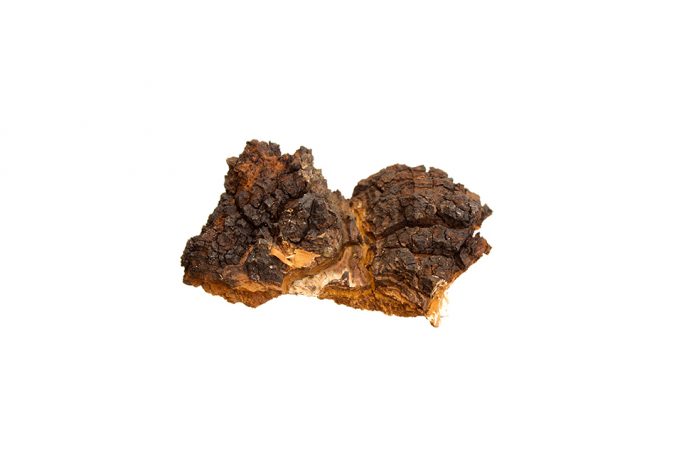The popularity of chaga mushroomed in 2012
By Noa Glouberman
If you’re not yet selling chaga mushroom, called a “Gift from God” by Siberians and “Diamond of the Forest” by the Japanese, chances are that you’ve at least heard its promotional buzz. The popularity of this wild fungus, formed beneath the surface of a host tree (usually birch) has skyrocketed in the past year.
Terry Willard, PhD, states that his Wild Rose Chaga Super Food is now the company’s third top-selling product, and Five Mushroom Blend which contains chaga is the second to top-seller (only beneath his trademark Wild Rose detox product).
What is it?
Its crusty black mass or “conk” formation with a foamy yellow-orange interior is often called a “mushroom,” but it’s actually a fungal body that precedes the organism’s spore-forming stage.
What makes it unique?
David Wolfe, author of the new book Chaga: King of the Medicinal Mushrooms, writes, “Chaga constitutes perhaps the greatest storehouse of medicinal healing properties of any single mushroom — or any herb, for that matter.” Gregg Elias of California-based Essential Living Foods, which sells organic chaga mushroom powder, agrees: “It is so powerfully life enhancing; I take it every day.”
How is it sourced?
Wild chaga grows in Russia, Europe, the U.S. and Canada. It is harvested from living birch trees, dried and ground before being distributed. Approximately five in every 20,000 trees will grow the fungus naturally.
Is it ecologically harvested?
Willard says it is sustainable if taken in specific ways. Wild Rose gets its chaga from Siberia because it is certified organic. There, 20 per cent of the chaga is ground up and returned to the soil beneath trees that have the growth. The chaga actually has a healing effect on the tree, not killing it as some fungus does. Since the growth is so rare, trees are purposely wounded at convenient (and not detrimental) locations to grow the mushroom. It takes two to three years for the fungus to grow.
Although chaga is grown in Canada, it does not yet have organic certification, according to Willard. (His son, Yarrow Willard’s company Harmonic Arts Botanical Dispensary uses Canadian chaga in its products, but only taken from birch trees that have been chopped for firewood.)
Retailer response?
Willard, who has been promoting chaga by offering retailers his product within a tea during his lectures, says it’s the best tasting mushroom available, which increases positive response and sales. It tastes like weak coffee with a hint of wintergreen. Elias says, “It has a wonderful, mild, almost woodsy flavour, slightly smoky, that really doesn’t need any sweetener.”
Costs?
Chaga has doubled in price as an ingredient in the past year due to publicity, partly because David Wolfe’s new book increased demand, says Willard. So far, this hasn’t affected product costs, however.
Is it new?
North American interest in chaga was sparked in the 1960s, after Nobel laureate Aleksandr Solzhenitsyn wrote about its benefits in his book, Cancer Ward. It has been wild-harvested in Siberia since the 70s for anti-cancer pharmaceuticals. In China and Siberia, the mushroom has been used for thousands of years to promote longevity. There is also evidence of its use as a remedy for cancer, gastritis, ulcers and tuberculosis in 16th-century Europe.
What’s in it?
Elias points to chaga’s high levels of anti-cancerous and immune-boosting beta-glucan polysacchariudes for its immune boosting action. It also has and stress-protective adaptogens, and sterols and triterpenes that aid digestion and detoxification. The mushroom boasts vitamins, minerals and amino acids, and also takes inedible medicinal properties from its host tree (like tumour-inhibiting betulinic acid, found in birch bark) and converts them into something we can ingest.
What does it do?
Chaga has been found in scientific research to boost immunity, lower stress, balance blood-sugar and treat cancer. According to Wolfe, the mushroom may be used to soothe pain, decrease inflammation, and fight viral infections (like flu, herpes, hepatitis and HIV). It also purifies the blood and balances blood-sugar. It may delay the growth of certain tumours, promote cardiovascular health, calm the nervous system, and help lower cholesterol.
How is it sold?
It is commonly promoted in powder form, but chaga is traditionally brewed as a tea. Since its delivery system is increased with steaming, adding it to tea or coffee may actually increase its efficacy, states Willard. However, it is sold as a superfood that is added to everything from chocolate to shakes, sauces and soups.
How quickly does it work?
Elias says that the speed of chaga’s efficacy depends on several factors, the most important one being the user’s health. “I don’t know hard facts, but people who’ve tried it have told me that their mood improved almost immediately, they had more energy and even their skin cleared up in a short amount of time.”
Are there different qualities?
“Many suppliers can’t guarantee the genetics or even the purity of the mushrooms they’re selling,” says Elias, adding that retailers should look for certified organic or wild-crafted chaga with no cracked spores. “It’s important to get it in its most natural form so that all of the enzymes and metabolites that are expressed by the mushroom are maintained.”
Because it is rare, chaga can also be manmade ─ cultivated in laboratories. This is promoted to have similar antioxidant effects to its wild cousin, but companies that use the natural ingredient disagree.







